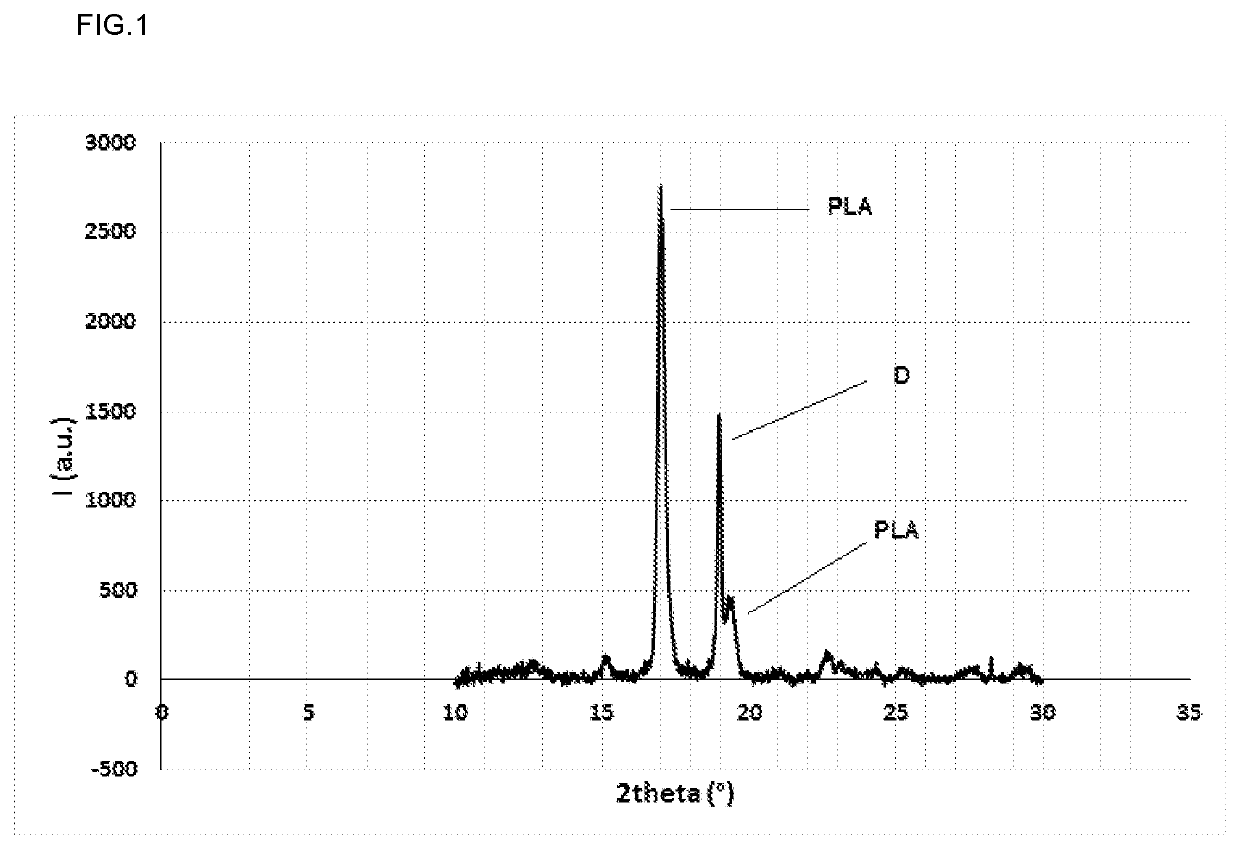Poly(lactic acid) composition comprising dipentaerythritol
a technology of dipentaerythritol and composition, applied in the direction of coatings, etc., can solve the problems of increasing the consumption of lactic acid, limiting the use of lactic acid in some applications, and affecting the overall crystallization rate of lactic acid, so as to improve the overall crystallization rate
- Summary
- Abstract
- Description
- Claims
- Application Information
AI Technical Summary
Benefits of technology
Problems solved by technology
Method used
Image
Examples
example 1
[0151]In this example four samples of neat PLA were melt blended with 1% by weight of dipentaerythritol, with 1% by weight of pentaerythritol, with 5% by weight of talc or with 5% by weight of PDLA, respectively, and were analysed by means of the dynamic DSC method described above. The results were also compared with the results obtained with neat PLA. Table 1 shows the crystallization results extracted from the DSC curves. The composition containing dipentaerythritol showed higher crystallization peak temperature (Tc) and higher degree of crystallinity (Xc) during the cooling scan at 10 and 25° C. / min on DSC in comparison with the neat PLA and the composition containing 5% by weight of talc. On the other hand, the composition containing dipentaerythritol showed similar crystallization peak temperature (Tc) and higher degree of crystallinity (Xc) during the cooling scan at 10° C. / min on DSC in comparison with the composition containing 5% by weight of PDLA. When the cooling scan was...
example 2
[0152]Tables 2 shows the crystallization results from the cooling scans at 10 and 25° C. / min on DSC of compositions that consisted of PLA melt blended with dipentaerythritol loaded at different weight percentages (1, 3, 5, 10 and 15% by weight of total composition weight) and different average particle sizes of dipentaerythritol (7 μm, referred herein to as DPS; 24 μm, referred herein to as DPM; and 74 μm, referred herein to as DPL.
[0153]In general, the crystallization peak temperature (Tc) decreased by increasing the content of dipentaerythritol, particularly when the lowest average particle size was used (DPS), irrespective of the cooling rate. When the higher cooling rate was applied, i.e. 25° C. / min, Tc shifted to lower temperatures and the degree of crystallinity of PLA decreased comparing to the 10° C. cooling rate.
[0154]Regarding the degree of crystallinity of the PLA obtained during the cooling step (Xc), it was almost maintained throughout the compositions containing 3, 5 a...
example 3
[0156]The potential impact of other additives currently used in the state of the art on the nucleating activity of dipentaerythritol was analysed. Compositions further comprising talc, PEG or Biostrength® 150 were tested using DSC.
[0157]Table 3 shows the crystallization results from the cooling scans at 10 and 25° C. / min on DSC of the indicated compositions. The composition that consisted of PLA, 5% by weight of dipentaerythritol and 5% by weight of talc (Sample 20), performed higher crystallization peak temperature and lower degree of crystallinity comparing with the composition that consisted of PLA with the same percentage of dipentaerythritol without any other additive (Sample 07, Table 2). However, the crystallization peak of said composition was higher comparing to the composition, which consisted of PLA and 5% by weight of talc, in Comparative sample 02 (see Table 1). Therefore, the incorporation of dipentaerythritol into a composition comprising PLA and an inorganic filler s...
PUM
| Property | Measurement | Unit |
|---|---|---|
| Fraction | aaaaa | aaaaa |
| Fraction | aaaaa | aaaaa |
| Fraction | aaaaa | aaaaa |
Abstract
Description
Claims
Application Information
 Login to View More
Login to View More - R&D
- Intellectual Property
- Life Sciences
- Materials
- Tech Scout
- Unparalleled Data Quality
- Higher Quality Content
- 60% Fewer Hallucinations
Browse by: Latest US Patents, China's latest patents, Technical Efficacy Thesaurus, Application Domain, Technology Topic, Popular Technical Reports.
© 2025 PatSnap. All rights reserved.Legal|Privacy policy|Modern Slavery Act Transparency Statement|Sitemap|About US| Contact US: help@patsnap.com



